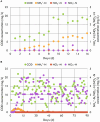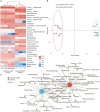Innovative inbuilt moving bed biofilm reactor for nitrogen removal applied in household aquarium
- PMID: 38694801
- PMCID: PMC11062409
- DOI: 10.3389/fmicb.2024.1373119
Innovative inbuilt moving bed biofilm reactor for nitrogen removal applied in household aquarium
Abstract
An innovative inbuilt moving bed biofilm reactor (MBBR) was created to protect fish from nitrogen in a household aquarium. During the 90 experimental days, the ammonia nitrogen (NH4+-N) concentration in the aquarium with the inbuilt MBBR was always below 0.5 mg/L, which would not threaten the fish. Concurrently, nitrite and nitrate nitrogen concentrations were always below 0.05 mg/L and 4.5 mg/L, respectively. However, the blank contrast aquarium accumulated 1.985 mg/L NH4+-N on the 16th day, which caused the fish to die. The suspended biofilms could achieve the specific NH4+-N removal rate of 45.43 g/m3/d. Biofilms presented sparsely with filamentous structures and showed certain degrees of roughness. The bacterial communities of the suspended biofilms and the sediment were statistically different (p < 0.05), reflected in denitrifying and nitrifying bacteria. In particular, the relative abundance of Nitrospira reached 1.4%, while the genus was barely found in sediments. The suspended biofilms showed potentials for nitrification function with the predicted sequence numbers of ammonia monooxygenase [1.14.99.39] and hydroxylamine dehydrogenase [EC:1.7.2.6] of 220 and 221, while the values of the sediment were only 5 and 1. This study created an efficient NH4+-N removal inbuilt MBBR for household aquariums and explored its mechanism to afford a basis for its utilization.
Keywords: ammonia; biofilm; moving bed biofilm reactor; nitrification; wastewater treatment.
Copyright © 2024 Zhou, Liu, Fan, Xu, Gao, Bi, Cheng, Huang, Zhao and Yang.
Conflict of interest statement
The authors declare that the research was conducted in the absence of any commercial or financial relationships that could be construed as a potential conflict of interest.
Figures






Similar articles
-
Response and recovery of nitrifying moving bed biofilm reactor systems exposed to 1°C with varying levels of ammonia starvation.Water Res. 2024 Sep 1;261:122026. doi: 10.1016/j.watres.2024.122026. Epub 2024 Jul 1. Water Res. 2024. PMID: 38971078
-
Performance and microbial ecology of a novel moving bed biofilm reactor process inoculated with heterotrophic nitrification-aerobic denitrification bacteria for high ammonia nitrogen wastewater treatment.Bioresour Technol. 2020 Nov;315:123813. doi: 10.1016/j.biortech.2020.123813. Epub 2020 Jul 10. Bioresour Technol. 2020. PMID: 32702578
-
Elucidating nitrifying performance, nitrite accumulation and microbial community in a three-stage plug flow moving bed biofilm reactor (PF - MBBR).Chemosphere. 2022 Jun;297:134087. doi: 10.1016/j.chemosphere.2022.134087. Epub 2022 Feb 22. Chemosphere. 2022. PMID: 35216986
-
Bacterial biofilm and extracellular polymeric substances in the moving bed biofilm reactor for wastewater treatment: A review.Bioresour Technol. 2022 Feb;345:126476. doi: 10.1016/j.biortech.2021.126476. Epub 2021 Dec 2. Bioresour Technol. 2022. PMID: 34864174 Review.
-
Simultaneous nitrification and denitrification in moving bed bioreactor and other biological systems.Bioprocess Biosyst Eng. 2021 Apr;44(4):635-652. doi: 10.1007/s00449-020-02475-6. Epub 2021 Jan 2. Bioprocess Biosyst Eng. 2021. PMID: 33387005 Review.
References
-
- Ashkanani A., Almomani F., Khraisheh M., Bhosale R., Tawalbeh M., AlJaml K. (2019). Bio-carrier and operating temperature effect on ammonia removal from secondary wastewater effluents using moving bed biofilm reactor (MBBR). Sci. Total Environ. 693:133425. doi: 10.1016/j.scitotenv.2019.07.231 - DOI - PubMed
-
- Cao J., Zhang T., Wu Y., Sun Y., Zhang Y., Huang B., et al. . (2020). Correlations of nitrogen removal and core functional genera in full-scale wastewater treatment plants: influences of different treatment processes and influent characteristics. Bioresour. Technol. 297:122455. doi: 10.1016/j.biortech.2019.122455, PMID: - DOI - PubMed
LinkOut - more resources
Full Text Sources

